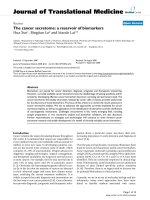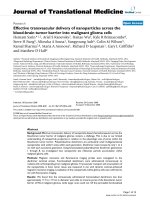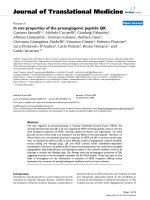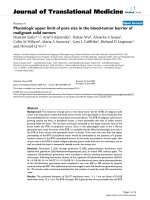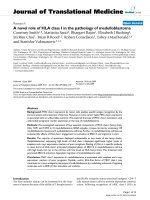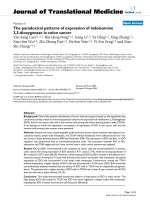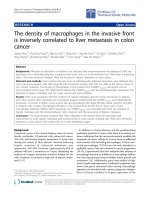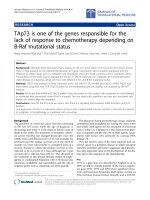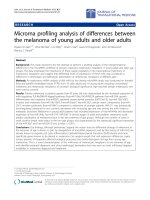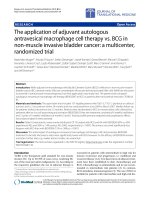báo cáo hóa học: " The Chinese version of the Pediatric Quality of Life Inventory™ (PedsQL™) 3.0 Asthma Module: reliability and validity" potx
Bạn đang xem bản rút gọn của tài liệu. Xem và tải ngay bản đầy đủ của tài liệu tại đây (285.67 KB, 11 trang )
RESEARCH Open Access
The Chinese version of the Pediatric Quality of
Life Inventory™ (PedsQL™) 3.0 Asthma Module:
reliability and validity
Lifen Feng
1
, Yingfen Zhang
2
, Ruoqing Chen
1,3
and Yuantao Hao
1*
Abstract
Background: Health-related quality of life (HRQOL) has been recognized as an important health outcome
measurement for pediatric patients. One of the most promising instruments in measuring pedia tric HRQOL
emerged in recent years is the Pediatric Quality of Life Inve ntory (PedsQL™). The PedsQL™ 3.0 Asthma Module,
one of the PedsQL™disease-specific scales, was designed to measure HRQOL dimensions specifically tailored for
pediatric asthma. The present study is aimed to evaluate the psychometric properties of the Chinese version of the
PedsQL™ 3.0 Asthma Module.
Methods: The PedsQL™ 3.0 Asthma Mo dule was translated into Chinese following the PedsQL™ Measurement
Model Translation Methodology. The C hinese version scale was administered to 204 children with asthma and
337 parents of children with asthma from four Triple A hospitals. The psychometric properties were then
evaluated.
Results: The percentage of missing value for each item of the scale ranged from 0.00% to 8.31%. All child self-
report subscales and parent proxy-report subscales approached or exceeded the minimum reliability standard of
0.70 for alpha coefficient, except 3 subscales of Young Child (aged 5-7) self-report (alphas ranging from 0.59 to
0.68). Test-retest reliability was satisfactory with intraclass correlation coefficients (ICCs) which exceeded the
recommended standard of 0.80 in all subscales. Correlation coefficients between items and their hypothesized
subscales were higher than those with other subscales. The PedsQL™ 3.0 Asthma Module distinguished between
outpatients and inpatients. Patients with mild asthma reported higher scores than those with moderate/severe
asthma in majority of subscales. The intercorrelations among the PedsQL™ 3.0 Asthma Module subscales and the
PedsQL™ 4.0 Generic Core Scales were in medium to large effect size. The child self-report scores were consistent
with the parent proxy-report scores.
Conclusions: The Chinese version of the PedsQL™ 3.0 Asthma Module has acceptable psychome tric properties,
except the internal consistency reliability for Young Child (aged 5-7) self-report. Further studies should be focused
on testing responsiveness of the Chinese version scale in longitudinal studies, evaluating the reliability and validity
of the scale for the patients with severe asthma or teens independently, and assessing HRQOL of children with
asthma in other areas.
Keywords: Asthma, Children, Health-related quality of life, Reliability, Validity, PedsQL
* Correspondence:
1
Department of Medical Statistics and Epidemiology, Center for Health
Information Research, School of Public Health, Sun Yat-sen University,
Guangzhou 510080, the People’s Republic of China
Full list of author information is available at the end of the article
Feng et al. Health and Quality of Life Outcomes 2011, 9:64
/>© 2011 Feng et al; lice nsee BioMed Central Ltd. This i s an Open Access article distributed under the terms of the Creative Commons
Attribution License ( which permits unrestricted use, distr ibution, and reproduction in
any medium, provided the original work is properly cited.
Background
Asthma is one of the most common chronic resp iratory
diseases of childhood in the world [1]. With the aggra-
vation of environm ental pollution, the pediat ric asthma
prevalence rate is increasing significantly in China as
well as other countries in the world [1-3]. With the
increasing pediatric asthma p revale nce rates, more and
more asthma-related clinical visits, hospitalizations and
mortalities were recorded, resulting in more physical
and emotional symptoms, greater activity limitations,
and poorer well-being and social functioning for the
asthmatic children [1,4,5]. Although the clinical and
physiological indicators, such as asthma symptoms and
pulmonary function testing, are important, health-
related quality of life (HRQOL) can provide a more
comprehensive description of the impact of the i llness
on the life of children with asthma [6]. Measures of
HRQOL are also valuable in documenting clinical
response to medical treatment and disease-related
changes in functioning. A w ell-developed instrument is
of decisive importance for the HRQOL assessment. The
instruments of HRQOL in pediatric asthma have been
well developed for a few years [7], yet further instru-
ment development was recently emphasized to broaden
the age range for both child self-report and parent
proxy-report [8]. Moreover, the HRQOL studies were
foc used on adult populat ions rather than on children in
China. The main reason for that is the lack of suitable
instruments, which need to be developed or adapted in
Chinese according to the established scientific criteria
and attributes [9].
The Pediatric Quality of Life Inventory (PedsQL™)
Measurement Model, firstly developed by Varni et al in
1999, is a promising instrument to assess HRQOL of
children aged 2-18 years [10,11]. With the progressive
evaluation and application, a series of scales, including a
General Core Scale and sev eral disease-specific modules,
have been developed and proved to be reliable and valid
[12-14]. The PedsQL™ has been translated into many
languages, and been widely used in more than 60 coun-
tries [15-17]. In China, the Chinese version of the
PedsQL™ 4.0 Generic Core Scale has been developed
and psychometrically evaluated [18]. The PedsQL™ 3.0
Asthma Module, one of the disease-specific scales, was
designed to measure HRQOL dimensions specifically
tailored to pediatric asthma. It has already been adapted
to apply in different countries with adequate reliability
and validity [19,20]. In order to i mprove the assessment
of the impact of asthma on the pediatric HRQOL in the
context with Chinese culture, we decided to generate
the Chinese version of the PedsQL™ 3.0 Asthma Mod-
ule, which could be used in combination wi th the Chi-
nese version of the PedsQL™4.0 Generic Core Scale
with the permission from PedsQL™ copyright owner,
James W. Varni.
This study aimed at evaluating the psychometric prop-
erties of the Chinese version of the PedsQL™ 3.0
Asthma Module, including the feasibility, internal con-
sistency reliability, test-retest reliability, item-subscale
correlations, construct validity and concordance between
child self-reports and parent proxy-reports.
Methods
Subjects and Settings
Subjects included children with asthma aged 5-18 and
parents of children with asthma aged 2-18. The pediatric
patients were eligible for the study if they were diag-
nosed with asthma conforming to the national diagnos-
tic standards of China. The parents were enrolled if they
were the parents of children, who were inpatients or
outpatients with asthma. Inpatient was defined as a
child who was hospitalized for necessary treatment.
Outpatient was defined as a child who attended the out-
patient department for routine visits. All the subjects
were approached with the permission from the doctors.
The subjects were excluded if 1) the parents were illiter-
ate or reluctant to participate, or 2) the children were
reported to have other chronic diseases or mental
disorders.
All subjects were recruited by convenient sampling
method from both outpatient and inpatient departments
of four Triple A hospitals in Guangzhou, China from
December, 2008 to June, 2009. Triple A hospitals are
the most-outstanding ones in China, and they provide
high-level medica l services and implement high medical
education and research tasks. This study was approved
by the Ethics Committee of School of Public Health,
Sun Yat-sen University. Informed consent forms were
signed by all subjects.
According to the formats of the Peds QL™ 3.0 Asthma
Module, the subjects wer e divided into four age groups:
Toddlers (aged 2-4), Young Children (aged 5-7), Children
(aged 8-12) and Teens (aged 13-18). According t o the
patient recruitment sources, subjects were divided into
the inpatient group and the outpatient group. Moreover,
according to the asthma severity reported by parents, the
subjects were divided into “ mild” , “ moderate” and
“severe” asthma group s. The ast hma severity was defined
by asking parents “How severe do you think the patient’s
asthma is during the past one month” ,withthree
response categories of “mild ”, “moderate” and “severe”.
Instruments
The Chinese versions of the PedsQL™ 3. 0 Ast hma
Module, 4.0 Generic Core Scale, and Family Information
Form were used in this study.
Feng et al. Health and Quality of Life Outcomes 2011, 9:64
/>Page 2 of 11
PedsQL™ 3.0 Asthma Module
The PedsQL™ 3.0AsthmaModulewasdevelopedto
measure asthma-specific aspects of HRQOL in children
aged 2-18. It is divided into seven forms, including parent
proxy-reports for Toddlers (aged 2-4), Young Children
(aged 5-7), Children (aged 8-12) and Teens (aged 13-18)
and self-reports for Young Children, Children and Teens.
Items in all forms are essentially ident ical , distinguish ing
only in appropriate language, or first- or third-person
tense. This 28-item instrument consists of 4 subscales:
Asthma Symptoms (11 items), Treatment Problems (11
items), Worry (3 items), and Communication (3 items).
The instructions ask how much of a problem each item
has been during the past one month. Responses are rated
on a 5-point Likert scale across child self-report for Chil-
dren and Teens as well as parent proxy-report (0 = never
a problem, 1 = almost never a problem, 2 = sometimes a
problem, 3 = often a problem, 4 = almost always a pro-
blem). A 3-point scale (0 = Not at all, 2 = Sometimes, 4 =
A lot) is utilized specifically for the child self-report for
Young Children. Items are rev ersed scored and linearly
transformed to a 0-100 scale (0 = 100, 1 = 75, 2 = 50, 3 =
25, 4 = 0), so that higher scores indicate better HRQOL.
Subscale scores are computed as the sum of the items
divided by the number of items answered. If more than
50% items in the scale are missing, the subscale scores
would not be computed [21].
PedsQL™4.0 Generic Core Scale
The PedsQL™4.0 Generic Core Scale is an instrument
with 23 items grouped into four subsca les: Physical
Functioning (8 items), Emotional Functioning (5 items),
Social Functioning (5 items) and School Functioning (5
items). The formats, instructions, Likert scales, and scor-
ing methods are the same as those of the PedsQL™ 3.0
Asthma Module. In addition to the four subscale scores,
three types of summary scores can be obtained in the
PedsQL™4.0 Generic Core Scale: 1) Physical Health
Summary Score equals Physical Functioning subscale
score; 2) Psychosocial Health Summary Score is c alcu-
lated as the sum of the 15 items of Emotional, Social,
and School Functioning subscales divided by the num-
ber of items answered; 3) Total Score is calculated as
the sum of all 23 items divided by the number of it ems
answered.
PedsQL™ Family Information Form
The PedsQL™ Family Information Form, completed
only by parents, contains general socio-demographic
information including the child’s date of birth, gender,
disease history, disease severity and the parent’s marital
status, education, occupation, family income, and pay-
ment method for the child’s medical care.
Cross-culture adaptation
The PedsQL™ Measurement Model Translation Metho-
dology was strictly followed in the linguistic translation
process of the PedsQL™ 3.0AsthmaModuleinthis
study [22]. It was summarized as the procedure of “For-
ward Translation - Backward T ranslation - Preliminary
Test - Field Test”.
The forward translation was performed by a pediatri-
cian and a medical English teacher independently, both
of whom were fluent in English. A multidisc iplinary
team including a pediatrician, a nurse, a health services
researcher and the project manager who was also a sta-
tistician, then reviewed the t wo drafts. They compared
the first two drafts, and made decisions on which trans-
lation was mor e equivalent to the original meaning and
suitable for Chinese. A single reconciled Chinese version
was developed after discussion.
The backward translation was performed by a bilin-
gual pediatrician who was working in the United States.
He was a native Chinese speaker and also was fluent in
English, and was not aware of the instrument before.
The backward translated version was compared with the
original one by the multidisciplinary team. Any inaccu-
racy or disaccord would be rectified to assure semantic
and conceptual equivalence. Then, the second Chinese
version was yielded.
Cognitive debriefing was conducted in 20 pediatric
patients with asthma and t heir parents. It was to con-
firm that the final Chinese version was understandable
and acceptable. This preliminary test was performed b y
face-to-face interviews in order to obtain comments and
suggestions on the Chinese scale from interviewees.
After some necessary revisions, the Chinese version
scale was finalized and approved for field-testing in the
current study.
All stages’ reports were sent to and accepted by Mapi
research Institute in Lyon, France, on behalf of Dr.
James W. Varni, the copyright owner of the PedsQL™.
Data collection
Five undergraduate students majoring in Preventive
Medicine and two nurses were trained as interviewers
by the project manager before the investigation. The
parents and their children completed the questionnaire
independently during the pediatric patients’ hospitaliza-
tion or outpatient department visit. All the parents were
asked to fill ou t th e PedsQL™ 3.0 Asthma Module, the
4.0 Generic Core Scale, and the Family Information
Form by self-administration. The children were required
to complete the PedsQL™ 3.0 Asthma Module and the
4.0 Generic Core Scale by self-administration except the
Young Children by interview-administration. The inter-
viewerswereavailabletoassistthecompletionofthe
questionnaires if the parents/children h ad questions on
semantic or conceptual understanding. They were also
responsible for collecting and checking the question-
naires to ensure that there were no m issing data or
Feng et al. Health and Quality of Life Outcomes 2011, 9:64
/>Page 3 of 11
logical mistakes. With the purpose of evaluating the
test-retest reliability of the scale, the PedsQL™ 3.0
Asthma Module was administered repeatedly to 50 com-
pliable hospitalized patients who had stable asthma
symptoms one week after the first interview.
Data Analysis
Data were an alyzed with SPSS 13.0 fo r windo ws.
Descriptive analysis was used for reporting the socio-
demographic characteristics of the parents and children.
Continuous variables were presented as mean and stan-
dard deviation (
¯
X ±
SD
). Categorical variables were
shown as observed frequencies and proportions. The
presence of floor and ceiling effects (>25% of the
respondents have the minimum and/or maximum score)
was evaluated for the four subscale scores [23].
The response rate of the Asthma Module was also cal-
culated in this study. It was defined as the number of
subjects in the analysis divided by the number of sub-
jects approached for the study.
Feasibility was determined by the average completion
time and percentage of mis sing value for each item. The
average completion time was defined as the mean of
completion time of the Asthma Module. The percentage
of missing value for each item was defined as the num-
ber of subjects who did not fill out the item divided by
the number of eligible subjects who were supposed to
complete the item.
Subscale internal consistency reliability was determined
using Cronbach’s alpha coefficient. Subscales with alpha
≥0.70 were recommended for comparing patient groups,
while a reliability criterion of 0.90 is recommended for
analyzing individual patient [24]. Intraclass correlation
coefficient (ICC) was used to evaluate the test-retest
reliability for the subscales. Values greater than 0.80 indi-
cated high test-retest reliability [25].
Multitrait scaling analysis (using Pearson correlation
analysis) was conducted to determine the item-subscale
correlations. Good scaling success was indicated if the
correlations between item and its hypothesized subscale
were stronger than those with other subscales.
Construct validity for the PedsQL™ 3.0 Asthma Mod-
ule was evaluated by means of the known-groups
method, which compares subscale scores across groups
that are known to differ in the health conditions being
investigated [14]. In this study, the independent sample
t test was used to compare: 1) children who were inpati-
ents versus those who were outpatients, 2) children with
mild asthma versus those with moderate/severe asthma.
It was hypothesized that outpatients would have higher
HRQOL than inpatients, based on p revious findings on
other PedsQL™ scales and the current literatures
regarding the correlations among the hospitalization, the
adverse outcome of asthma and the conceptualization of
HRQOL, which was a marker of disease severity
[14,26-29]. It was also hypothesized that the children
with mild asthma would have higher subscale scores
than children with moderate/severe asthma, based on
the previous findings on the association between the
adverse asthma outcome and the patient’s HRQOL [30].
Construct validity for the PedsQL™ 3.0 Asthma Mod-
ule was further evaluated through analyses of the inter-
correlations among the PedsQL™ 3.0 Asthma Module
subscale scores and the PedsQL™ 4.0 Generic Core
Scale Total Score. It had been reported that computing
the intercorrelations among scales provides initial infor-
mation on the construct validity of an instr ument [14].
Correlation effect sizes were desi gned as small (0.10-
0.29), medium ( 0.30-0.49), and large (≥0.50) [31]. Inter-
correlations were expected to demonstrate medium to
large effect size [25]. On the grounds that disease-specific
symptoms could be used as causal indicators of generic
HRQOL [25], it was hypothesized that higher Asthma
Symptom subscale score (fewer symptoms) would be cor-
related with higher Generic Core Scale Total Score (bet-
ter overall HRQOL). Based on the previous findings on
the association between disease-specificsideeffectsor
barriers to treatment adherence and patient’ s generic
HRQOL [32], it was hypothesized that higher Treat ment
Problems subscale sc ore (fewer treatment s ide effects or
barriers to adherence) would be correlated with higher
Generic Core Scale Total Score (better overall HRQOL).
It was further hypothesized that higher Worry and Com-
munication subscale scores (less worry and better com-
munication respectively) would be correlated with higher
Generic Core Scale Total Score (better overall HRQOL)
based on the previous findings on other Ped sQL™ dis-
ease-specific module [33].
The concordance between self-reports and proxy-
reports was evaluated by ICC and paired sample t tests.
ICCs were designated as poor to fair agreement (≤0.40),
moderate agreement (0.41 to 0.60), good agreement (0.61
to 0.80), and excellent agreement (>0.80) [34]. Addition-
ally, parent-child intercorrelations were computed to
examine cross-informant variance. Correlation effect
sizes are designed as small (0.10-0.29), medium (0.30-
0.49), and large (≥0.50) [31]. Parent-child concordance
for the same subscale score was expected to demonstrate
medium to large effect size, but not so large that child
and parent reports would be redundant, based on pre-
vious findings of PedsQL™ research studies [33,35].
Results
Subjects
Participants were children with asthma (n = 204) and
parents of children with asthma (n = 337) approached
for the study, with 337 families collected overall. For
204 children aged 5-18, both child self-report and
Feng et al. Health and Quality of Life Outcomes 2011, 9:64
/>Page 4 of 11
parent proxy-report were available, while only parent
proxy-report were available for 133 children aged 2-4.
The average age of the pediatric patients wa s 6.36
years (SD = 2.96) with a range of 2.00 to 14.30 years. A
total of 232 of the patients were boys, 104 were girls
and 1 child’ s gender was not reported. Of the pediatric
patients, 39.47% were Toddlers, 30.86% were Young
Children, 27.00% were Children, and 2.67% were Teens.
In order to guarantee the power of test, the groups of
Children and Teens were combined into one group for
subsequent analyses because of the small sample size of
Teens (n = 9). In this study, the majority of the patients
(67.36%) suffered from mild asthma, while others suf-
fered from moderate and severe asthma (29.67% and
2.97% respectively). Since the sample size of patients
with severe asthma was small (n =10),wecombined
themoderateasthmagroupwithsevereasthmagroup
to ensure the power of test in the analyses. All the
pediatric patients (included 50 inpatients and 287 outpa-
tients) had an average history of asthma of 3.06 year s
(SD = 2.33). A total of 337 parents participate d in the
study. Detailed sample characteristics are presented in
Table 1.
Descriptive Analysis
Table 2 displays means, standard deviations, floor effects
and ceiling effects on each subscale score of the
PedsQL™ 3.0 A sthma Module. The Asthma Module
show ceiling effects in all subscale scores except Asthma
Symptoms subscale score. Additionally, patients with
mild disease had greater ceiling effects than patients
with moderate/severe disease. However, there was no
floor effect in all subscale scores. The mea ns and stan-
dard deviations for inpatients, outpatients and patients
with different disease severity are presented in Table 3.
Response Rate and Feasibility
The response rate for the children and the parents were
97.61% and 98.83% respectively. There were 209 chil-
dren with asthma and 341 parents of children wit h
asthma participating in the study. A total of 204 chil-
dren completed the questionnaire, 4 children refused to
participate and 1 child answered less than 50% of the
items. A total of 337 parents completed the question-
naire, 4 parents refused to participate since they were in
a rush or unwilling to do it. The average completion
time of the PedsQL™ 3.0 Asthma Module was about 5
minutes.Thepercentageofmissingvalueforeachitem
of the scale ranged from 0.00% to 8.31% (Table 4).
Reliability
Cronbach’ s alpha coefficients for the PedsQL™ 3.0
Asthma Module across all ages are presented in Table 5.
For the total sample, all coefficients were higher than
0.70 in all subscales except the Treatment Problems and
Worry subscales (a = 0.69 and 0.65 respectively) in the
child self-report. The subscales of child self-report and
parent proxy-report across all ages approached or
exceeded the minimum reliability standard 0.70 except 3
subscales of Young Child self-report. The ICCs being
used to examine the test-retest reliability were all higher
than 0.80 in all subscales (Table 5).
Item-subscale correlations
Pearson correlation coefficients between items and sub-
scale scores are presented in Table 4. The result showed
that items had moderate to strong correlations with
their hypothesized subscales, which were higher than
those with other subscales (P < 0.05).
Construct validity
Construct validity of the PedsQL™ 3.0 Asthm a Module
assessed by the known-groups method is presented in
Table 3. For every comparison for subscale scores, there
was a statistically significant difference between inpati-
ents and outpatients (P < 0.05). Furthermore, the chil-
dren with mild asthma reported significantly higher
subscale scores than the children with moderate/severe
asthma in most of the subscales (P < 0.05).
The result of the intercorrelations between the
PedsQL™ 3.0 Asthma Module subscale scores and the
Table 1 Demographic Characteristics of the Samples
Demographic Characteristics N %
Characteristics of Parents
Relationship to Patient
Mother 247 73.29
Father 67 19.88
Others 23 6.83
Characteristics of Children
Ages (years)
2~4* 133 39.47
5~7 104 30.86
8~12 91 27.00
13~18 9 2.67
Gender
Male 232 68.84
Female 104 30.86
Not reported 1 0.30
Groups
Inpatient 50 14.84
Outpatient 287 85.16
Disease Severity
Mild 227 67.36
Moderate 100 29.67
Severe 10 2.97
* The information of Toddlers was offered by their parents.
Feng et al. Health and Quality of Life Outcomes 2011, 9:64
/>Page 5 of 11
PedsQL™ 4.0 Generic Core Scale Total Score is shown
in Table 6. The correlations were in medium to large
effect size, with largest intercorrelations between the
PedsQL™ 3.0AsthmaModuleAsthmaSymptomssub-
scale score and the PedsQL™ 4.0 Generic Core Scales
Total Score for chil d and parent report ( r =0.64andr
= 0.65, respectively).
Self-report/Proxy-report concordance
The parent/child concordance intercorrelations matrix is
shown in Table 6. Most intercorrelations of subscales
between child self-report and parent proxy-report were
in medium to large effect size range.
The result of paired sample t tests for the total sample
showed that there was no significant difference between
the subscale scores of self-reports and those of proxy-
reports. The values of ICCs were all greater than 0.77
(shown in Table 7).
Discussion
The PedsQL™ 3.0 Asthma Module, one of the Ped-
sQL™disease-specific modules,isdesignedtomeasure
Table 2 Subscales descriptives for the PedsQL™ 3.0 Asthma Module for the self-report and proxy-report
Subscale Number of items N Mean SD % Floor* % Ceiling*
Total sample Mild Moderate
/Severe
Total sample Mild Moderate
/Severe
Self-Report
Asthma Symptoms 11 204 81.23 12.09 0.0 0.0 0.0 3.4 5.0 0.0
Treatment Problems 11 204 91.46 9.47 0.0 0.0 0.0 30.4 36.2 17.5
Worry 3 201 84.89 18.45 0.0 0.0 0.0 46.6 49.6 39.7
Communication 3 204 88.97 19.38 1.0 0.0 1.4 64.2 66.7 58.7
Proxy-Report
Asthma Symptoms 11 337 79.72 14.29 0.0 0.0 0.0 4.5 6.6 0.0
Treatment Problems 11 337 89.78 12.19 0.0 0.0 0.0 36.2 43.2 21.8
Worry 3 311 87.45 21.07 1.0 1.0 1.0 64.3 73.3 46.7
Communication 3 318 86.61 21.57 1.2 0.9 1.9 61.3 67.0 50.0
*% Floor/%Ceiling = the percentage of scores at the extremes of the scaling range
SD = standard deviation
Table 3 Construct Validity of the Chinese Version Scale Assessed by the Known-groups Method (Mean(SD))
Subscales Sample groups Disease severity
N * inpatient outpatient t † P ‡ N § mild moderate
/severe
t † P ‡
self-report
Asthma Symptoms 28/176 69.16
(15.49)
83.15
(10.27)
6.19 <0.001 141/63 84.56
(9.58)
73.77
(13.77)
6.45 <0.001
Treatment Problems 28/176 86.68
(11.63)
92.22
(8.88)
2.93 0.004 141/63 92.74
(8.65)
88.58
(10.61)
2.96 0.003
Worry 28/176 73.21
(21.91)
86.74
(17.19)
3.72 <0.001 141/63 86.29
(18.29)
81.75
(18.57)
1.63 0.104
Communication 28/173 81.55
(28.63)
90.17
(17.26)
2.21 0.029 138/63 89.73
(19.03)
87.30
(20.18)
0.82 0.410
proxy-report
Asthma Symptoms 50/287 68.41
(13.66)
81.69
(13.47)
6.42 <0.001 227/110 86.33
(9.99)
66.07
(11.98)
16.33 <0.001
Treatment Problems 50/287 81.05
(13.24)
91.30
(11.35)
5.75 <0.001 227/110 92.34
(10.50)
84.50
(13.70)
5.80 <0.001
Worry 50/261 73.83
(21.89)
90.05
(19.92)
5.19 <0.001 206/105 91.02
(18.90)
80.44
(23.34)
4.30 <0.001
Communication 40/269 74.66
(25.51)
88.79
(20.07)
4.33 <0.001 212/106 89.07
(20.29)
81.68
(23.24)
2.91 0.004
* inpatients/outpatients
§ mild/moderate/severe
† independent sample t test
‡ P values for the t test
Feng et al. Health and Quality of Life Outcomes 2011, 9:64
/>Page 6 of 11
the asthma specific HRQOL of pedi atric patients. With
satisfactory psychometric properties, both the child self-
report and the parent proxy-report, being available, brief
and applicable for c hildren with a broad age range,
make the PedsQL™ a good HRQOL measurement.
Additionally, while there are a number of asthma dis-
ease-specific instruments available [8], t here are poten-
tial benefits of integrating generic and disease-specific
approaches in measuring HRQOL [10]. The develop-
ment of the Chinese version of the PedsQL™ 3.0
Asthma Module will not only meet an urgent demand
in the HRQOL assessment in children with asthma in
China, but also make it possible to c ompare their
HRQOL across countries.
This study presents the measurement properties for
the Chinese version of the PedsQL™3.0 Asthma Mod-
ule. To our knowledge, this is also the first time that the
PedsQL™3.0 Asthma Module was tested on children
with asthma in China. The analyses support the feasibil-
ity, reliability and validity of the PedsQL™3.0 Asthma
Module as a child self-report and parent proxy-report
HRQOL measurement instrument for pediatric asthma.
The Chinese version of the PedsQL™3.0 Asthma
Module, developed strictly following the PedsQL™
Measurement Model Translation Methodology, was fea-
sible and practical. In particular, short completing time
made this instrument particularly applicable to the fast-
pace setting of an outpatient clinic. However, it is found
Table 4 Item-subscale Correlations of the PedsQL™ 3.0 Asthma Module
§
Subscales & Items Parent proxy-report Child self-report
A TX W C missing
(n/%)
A TX W C missing
(n/%)
Asthma Symptoms (A)
1. pain or tightness in his or her chest
0.68 0.34 0.35 0.18 0/0.00 0.50 0.33 0.28 0.08* 0/0.00
2.feeling wheezy
0.73 0.37 0.32 0.22 0/0.00 0.65 0.29 0.32 0.10* 0/0.00
3. having asthma attacks
0.75 0.39 0.34 0.22 0/0.00 0.67 0.38 0.17 0.01* 0/0.00
4.getting scared while having asthma attacks
0.65 0.41 0.34 0.25 0/0.00 0.43 0.29 0.17 0.04* 0/0.00
5.getting out of breath
0.77 0.46 0.39 0.28 0/0.00 0.62 0.32 0.40 0.18 0/0.00
6.coughing
0.60 0.31 0.16 0.19 0/0.00 0.44 0.24 0.14 0.03* 0/0.00
7.taking a deep breath
0.70 0.44 0.36 0.32 0/0.00 0.55 0.38 0.21 0.09* 0/0.00
8. having a stuff or runny nose
0.52 0.25 0.14 0.20 0/0.00 0.47 0.33 0.07* 0.25 0/0.00
9.waking up at night with trouble breathing
0.73 0.46 0.32 0.36 0/0.00 0.47 0.31 0.22 0.0.9* 0/0.00
10.playing with pets
0.53 0.48 0.32 0.35 1/0.30 0.37 0.17 0.16 0.15 1/0.49
11. playing outside
0.61 0.53 0.39 0.30 0/0.00 0.48 0.19 0.25 0.11* 0/0.00
Treatment Problems (TX)
1.medicines making him or her feel sick 0.42
0.62 0.37 0.32 0/0.00 0.32 0.56 0.27 0.25 0/0.00
2.trouble sleeping because of medicines 0.43
0.60 0.29 0.34 0/0.00 0.20 0.33 0.12* 0.15 0/0.00
3. trouble using his or her inhaler 0.35
0.56 0.26 0.26 10/2.97 0.31 0.52 0.11* 0.23 7/3.43
4.disliking carrying his or her inhaler 0.33
0.57 0.27 0.36 9/2.67 0.21 0.47 0.06* 0.29 7/3.43
5.being responsible for his or her medicines 0.39
0.65 0.37 0.31 0/0.00 0.32 0.58 0.22 0.22 0/0.00
6.controlling his or her asthma 0.64
0.67 0.33 0.26 0/0.00 0.53 0.60 0.36 0.23 0/0.00
7.refusing to take medicines 0.29
0.66 0.33 0.28 0/0.00 0.23 0.51 0.12* 0.10* 0/0.00
8.forgetting to take medicines 0.31
0.61 0.37 0.36 1/0.30 0.21 0.51 0.24 0.13* 0/0.00
9.getting anxious when he or she has to have medical treatments 0.40
0.73 0.50 0.37 0/0.00 0.29 0.49 0.30 0.27 0/0.00
10.getting anxious about going to the doctor 0.40
0.68 0.40 0.34 0/0.00 0.26 0.43 0.14 0.07* 0/0.00
11.getting anxious about going to the hospital 0.38
0.68 0.49 0.36 0/0.00 0.23 0.43 0.22 0.08* 0/0.00
Worry (W)
1.worrying about side effects from medical treatments 0.39 0.51
0.91 0.28 28/8.31 ‡ 0.34 0.31 0.69 0.15 0/0.00
2.worrying about whether or not medical treatments are working 0.42 0.53
0.93 0.38 28/8.31 ‡ 0.28 0.35 0.77 0.25 0/0.00
3.worrying about his or her asthma 0.42 0.52
0.92 0.31 22/6.53 ‡ 0.35 0.28 0.83 0.08* 0/0.00
Communication (C)
1.telling the doctors and nurses how he or she feels 0.35 0.47 0.32
0.91 16/4.75 ‡ 0.16 0.36 0.14 0.82 2/0.98
2.asking the doctors or nurses questions 0.34 0.46 0.32
0.96 23/6.82 ‡ 0.14* 0.27 0.17 0.87 7/3.43
3.explaining his or her illness to other people 0.37 0.49 0.36
0.93 20/5.93 ‡ 0.22 0.35 0.19 0.90 2/0.98
§ Values denote Pearson correlation coefficients. The P value of all coefficients above is less than 0.05, except that noted by “*”.
Underlined values represent correlations between items and their hypothesized subscales.
‡ For the Worry and Communication subscales (parent proxy-report), the higher percentage of missing values is primarily from the Toddler version.
Feng et al. Health and Quality of Life Outcomes 2011, 9:64
/>Page 7 of 11
that there were several items of Worry and Communica-
tion subscales in the parent proxy-report, i.e. “worrying
about side effects from medical treatments” ,hadahigh
missing rate. We also found tha t the higher percentage
of missing values was primarily from the Toddler ver-
sion. The reason may be that, parents regarded their
children as too young to understand the medical treat-
ment effect and side effect or communicate with doctors
and nurses. This finding was consistent with those of
the prior studies with other PedsQL™disease-specific
modules [33]. This indicated that some modifications
for the items of Worry and Communication subscales in
Toddler version scale were necessary. In addition, ceiling
effect was found in the study, but no floor effect was
observed in most o f the PedsQL™3.0 Asthma Module
subscales. Considering that themajorityofpatients
suffering from mild asthma (about 70%) might account
for the high ceiling effect, exploratory analyses were
conducted for patients with different disease severity.
We found that patients with mild disease had greater
ceiling effects than patients with moderate to severe dis-
ease. This suggested that th e instrument could show the
HRQOL changes in pati ents who were experienci ng
adverse impacts from their asthma even though it might
not be sensitive to perceive HRQOL improvement in
patients who were relatively doing well.
Internal consistency reliability was evaluated using
Cronbach’s alpha coefficients. Consistent with the coeffi-
cients reported by Varni et al [14], all the Cronbach’s
alpha coefficients (except Treatment Problems and
Worry subscales in the child self-report) exceeded the
recommended minimum alpha coefficient standard of
Table 5 Reliability for PedsQL™ 3.0 Asthma Module for self and proxy-reports
Subscale Age group (a *) Age group(ICC
§
)
Toddlers
(2-4)
Young
Children
(5-7)
Children &
Teens
(8-18)
Total
Sample
Toddlers
(2-4)
Young
Children
(5-7)
Children &
Teens
(8-18)
Total
Sample
Self-Report
Asthma Symptoms N/A 0.65 0.78 0.72 N/A 0.95 0.88 0.92
Treatment
Problems
N/A 0.59 0.77 0.69 N/A 0.79 0.93 0.89
Worry N/A 0.68 0.62 0.65 N/A 0.80 0.95 0.90
Communication N/A 0.86 0.77 0.82 N/A 0.97 0.96 0.97
Proxy-Report
Asthma Symptoms 0.88 0.86 0.87 0.87 0.94 0.91 0.94 0.93
Treatment
Problems
0.81 0.86 0.84 0.85 0.91 0.96 0.91 0.92
Worry 0.91 0.91 0.91 0.91 0.88 0.96 0.95 0.92
Communication 0.94 0.89 0.92 0.93 0.99 0.99 0.96 0.99
* a = Cronbach’s alpha coefficients
§ ICC = Intraclass correlation coefficient
N/A = not applicable
Table 6 Pearson Correlations Coefficients Among PedsQL™ Subscales*
Subscales Tot PH PSY EM SOC SCH A TX W C
Total score (Tot)
0.44 0.82 0.94 0.76 0.71 0.72 0.64 0.59 0.45 0.44
Physical Health (PH) 0.85
0.45 0.58 0.46 0.45 0.45 0.57 0.47 0.37 0.34
Psychosocial Health (PSY) 0.96 0.67
0.40 0.81 0.76 0.76 0.57 0.57 0.43 0.43
Emotional Functioning (EM) 0.79 0.52 0.84
0.25 0.48 0.39 0.51 0.54 0.39 0.34
Social Functioning (SOC) 0.81 0.62 0.81 0.55
0.36 0.35 0.36 0.39 0.31 0.35
School Functioning (SCH) 0.74 0.49 0.78 0.43 0.50
0.49 0.45 0.39 0.29 0.31
Asthma Symptoms (A) 0.65 0.60 0.60 0.51 0.44 0.51
0.56 0.58 0.42 0.20
Treatment Problems (TX) 0.60 0.46 0.60 0.56 0.49 0.42 0.59
0.30 0.40 0.38
Worry (W) 0.41 0.34 0.40 0.34 0.35 0.29 0.46 0.56
0.32 0.20
Communication (C) 0.37 0.31 0.36 0.31 0.37 0.26 0.38 0.51 0.35
0.27
*Correlations for patient self-report are shown above the diagonal.
Underlined values represent correlations between patient self-report and parent proxy-report.
Correlations for parent proxy-report are shown below the diagonal.
Correlations among Generic Core Scale Total Score with the Asthma Module subscale scores are in boldface.
Effect size are designated as small (0.10-0.29), medium (0.30-0.49), and large (≥0.50)
Feng et al. Health and Quality of Life Outcomes 2011, 9:64
/>Page 8 of 11
0.7 for group comparisons, indicating acceptable reliabil-
ity of the C hines e version scale. Considering that scores
may be age-dependent, exploratory analyses were con-
ducted for different age groups. The internal consistency
reliabilities of the PedsQL™3.0AsthmaModulesub-
scales across all ages generally approached or exceeded
the recommend standard of 0.7 except for the Young
Child self-report. The coefficients did not achieve the
standard value probably resulting from the small sample
size (n <100). On the other hand, the bias due to differ-
ent modes of administration could not be excluded. The
Young Children completed the scale by face-to-face
interviews which might bias the answers due to misun-
derstanding, even though all the investigators were
trained in advance. It’s suggested that the subscales that
did not achieve the standard should be used only for
descriptive or exploratory analyses unless updated find-
ings are obtained in further testing [14].
Test-retest reliability was examined by computing
ICC. For the total sample and the patients of different
age groups, the ICCs were close to or higher than the
recommend standard of 0.8, indicating a good test-retest
reliability of the scale. This finding demonstrated that
the Chinese version of the PedsQL™3.0 Asthma Module
was stable over time.
Inordertoevaluatetheitem-subscalecorrelations,
Pearson correlations between items and subscale scores
were analyzed. The results of the corre lations between
items and their hypothesized subscales being high but
those between items and other subscales being weak
indicated good scaling success for child self-repor ts and
parent proxy-reports.
Construct validity of the Chinese version of the
PedsQL™3.0 Asthma Module was assessed by means of
known-groups method. The hypothesis was supported
that the outpatients had higher HRQOL than inpatients.
Another hypothesis that the children with mild asthma
would manifest higher HRQOL than the children with
moderate/severe asthma was also verified in all subscales
except child self-report Worry and Communication. The
subscales with unqualified discriminate ability, which
was probably yielded by the relatively small sample size
of the children with moderate/severe asthma (n =63),
were recommended for further testing. In addition, the
children’s asthma s everity determined ba sed on parent-
reported information might be less reliable than that
categorized by the clinical and physiological indicators,
such as asthma symptoms and pulmonary functio n test-
ing [36]. This might partly accounted for the unqualified
discriminate ability of the Asthma Module.
Construct validity was further tested by analyzing the
intercorrelations among the Chinese version of the
PedsQL™ 3.0 Asthma Module subscale scores and the
validated Chinese version of the PedsQL™ 4.0 Generic
Core Scale Total Score. Similar to the findings in a pre-
vious study [14], the intercorrelations between the
PedsQL™ 4.0 Generic Co re Scale Total Score and
PedsQL™ 3.0 Asthma Module subscale scores were
consistent with the conceptualization of disease-specific
symptoms as causal indicators of HRQOL.
Based on the results of paired sample t tests and ICCs,
it was believed that good concordance existed in child
self-reports and parent proxy-reports. Moreover, the
cross-informant variance was observed in the parent-
child intercorrelations matrix. That supports the need to
measure the perspectives of child and parent informants
in evaluating HRQOL in pediatric asthma. This finding
was consistent with that of a previous study [14]. The
validated parent proxy-report can be used to estimate
pediatric HRQOL when the child is unable or unwilling
to complete the HRQOL measurement, or treated a s
proxy information when young child self-report scale
reliabilities do not achieve the standard [14].
Several limitatio ns in this study should be considered.
Firstly, the responsiveness of the Chinese version of the
PedsQL™3.0 Asthma Module was not evaluated in the
study. Responsiveness which is used to detect the
HRQOL changes w hile a patient’s health status changes
over time can be regarded as providing additional evi-
dence of validity of an instrument [25]. Furthe r longitu-
dinal studies were advised to assess the responsiveness.
Secondly, the sample size of the severe asthma group
and the Teens group was very small. In order to guaran-
tee the power of test, we co mbined the moderate
Table 7 The Concordance between Self-report and Proxy-report of the PedsQL™ 3.0 Asthma Module
Subscales Total sample Young Children (5-7) Children &Teens (8-18)
t* P
§
ICC t* P ICC t* P ICC
Asthma Symptoms -1.35 0.177 0.87 -2.31 0.023 0.84 0.57 0.570 0.89
Treatment Problems -0.97 0.334 0.80 -1.69 0.094 0.80 0.18 0.856 0.81
Worry 1.19 0.237 0.77 0.11 0.909 0.78 1.51 0.135 0.77
Communication -0.39 0.697 0.81 -1.16 0.250 0.85 0.58 0.562 0.75
* paired sample t test
§ P values for the t tests
ICC = Intraclass correlation coefficient
Feng et al. Health and Quality of Life Outcomes 2011, 9:64
/>Page 9 of 11
asthma group a nd the severe asthma group, as well as
the Children group and Teens group, into one group for
subsequent anal yses. Thus, the reliability and validity of
the scale for the patients with severe asthma or teens
need to be further confirmed independently. Thirdly, all
the subjects in this study we re recruited in a large city
(Guangzhou) in China. Thus, whether the Chinese ver-
sion of the PedsQL™ 3.0 Asthma Module can be gener-
alized to other regions remains a question. Further
studies conducted in other areas are suggested.
Conclusions
This study is imp ortant as being the fi rst time to intro-
duce the PedsQL™ 3.0 Asthma Module to China and
evaluate the psychometric properties of the Chinese ver-
sion scale based on the Chinese pediatric asthma
patients. The data collected by our study provide rea-
sonableevidencetoshowthattheChineseversionof
the PedsQL™ 3.0 Asthma Module has acceptable psy-
chometric properties except the internal consistency
reliability for Young Child self-report. Further studies
should focus on t esting responsiveness of the Chinese
version scale in longitudinal studies, evaluating the relia-
bility and validity of the scale for the patients with
severe asthma or teens independently, and assessing
HRQOL of children with asthma in other areas.
List of abbreviations
PedsQL™: Pediatric Quality of Life Inventory™; HRQOL: Health-Related Quality
of Life; ICC: Intraclass correlation coefficient.
Acknowledgements
We sincerely thank the children and parents who took part in this study.
Special thanks to Dr James W. Varni for permitting us to translate the
instrument. We are also grateful to all the experts involved in the translation
process and the supports from the four hospitals in Guangzhou. We thank
Christine Yin for her helpful comments on this manuscript. There was no
funding for this research.
Author details
1
Department of Medical Statistics and Epidemiology, Center for Health
Information Research, School of Public Health, Sun Yat-sen University,
Guangzhou 510080, the People’s Republic of China.
2
Special Center, the First
Affiliated Hospital of Sun Yat-sen University, Guangzhou 510080, the People’s
Republic of China.
3
Department of Epidemiology, Key Lab of Public Health
Safety of the Ministry of Education, School of Public Health, Fudan
University, Shanghai 200032, the People’s Republic of China.
Authors’ contributions
LF conceptualized and designed the study, acquired, analyzed and
interpreted the data, and drafted the manuscript. YZ conceptualized and
designed the study, acquired, analyzed and interpreted the data, and revised
the manuscript. RC conceptualized and designed the study, acquired data,
and revised the manuscript. YH conceptualized and designed the study,
supervised the data analysis and revised the manuscript. All authors read
and approved the final manuscript.
Competing interests
The authors declare that they have no competing interests.
Received: 4 May 2011 Accepted: 7 August 2011
Published: 7 August 2011
References
1. Akinbami LJ, Schoendorf KC: Trends in childhood asthma: prevalence,
health care utilization, and mortality. Pediatrics 2002, 110:315-322.
2. National cooperation group on childhood asthma: A nationawide survey
in China on prevalence of asthma in urban children. Chinese Journal of
Pediatrics 2003, 41:5.
3. Asher MI: Recent perspectives on global epidemiology of asthma in
childhood. Allergol Immunopathol (Madr) 2010, 38:83-87.
4. Christie MJ, French D, Sowden A, West A: Development of child-centered
disease-specific questionnaires for living with asthma. Psychosom Med
1993, 55:541-548.
5. Juniper EF, Guyatt GH, Feeny DH, Ferrie PJ, Griffith LE, Townsend M:
Measuring quality of life in children with asthma. Qual Life Res 1996,
5:35-46.
6. Chan KS, Mangione-Smith R, Burwinkle TM, Rosen M, Varni JW: The
PedsQL: reliability and validity of the short-form generic core scales and
Asthma Module. Med Care 2005, 43:256-265.
7. Feeny D, Juniper EF, Griffith PLE, Guyatt GH: Why not just ask the kids?
Health-related quality of life in children with asthma. In Measuring
Health-Related Quality of Life in Children and Adolescents: Implications for
Research and Practice. Edited by: Drotar D. Mahwah, NJ: Lawrence Erlbaum
Associates, Inc; 1998:171-185.
8. French DJ: Asthma. In Quality of Life in Child and Adolescent Illness:
Concepts, Methods and Findings. Edited by: Koot HM, Wallander JL. East
Sussex, UK: Brunner-Routledge; 2001:241-265.
9. Scientific Advisory Committee of the Medical Outcomes Trust: Assessing
health status and quality-of -life instruments: attributes and review
criteria. Qual Life Res 2002, 11:193-205.
10. Varni JW, Seid M, Rode CA: The PedsQL: measurement model for the
pediatric quality of life inventory. Med Care 1999, 37:126-139.
11. Eiser C, Morse R: Quality-of-life measures in chronic diseases of
childhood. Health Technol Assess 2001, 5:1-157.
12. Eiser C, Vance YH, Horne B, Glaser A, Galvin H: The value of the PedsQLTM
in assessing quality of life in survivors of childhood cancer. Child Care
Health Dev 2003, 29:95-102.
13. Laffel LM, Connell A, Vangsness L, Goebel-Fabbri A, Mansfield A,
Anderson BJ: General quality of life in youth with type 1 diabetes:
relationship to patient management and diabetes-specific family
conflict. Diabetes Care 2003, 26:3067-3073.
14. Varni JW, Burwinkle TM, Rapoff MA, Kamps JL, Olson N: The PedsQL in
pediatric asthma: reliability and validity of the Pediatric Quality of Life
Inventory generic core scales and asthma module. J Behav Med 2004,
27
:297-318.
15.
Felder-Puig R, Frey E, Proksch K, Varni JW, Gadner H, Topf R: Validation of
the German version of the Pediatric Quality of Life InventoryTM
(PedsQLTM) in childhood cancer patients off treatment and children
with epilepsy. Quality of Life Research 2004, 13.
16. Bastiaansen D, Koot HM, Bongers IL, Varni JW, Verhulst FC: Measuring
quality of life in children referred for psychiatric problems: psychometric
properties of the PedsQL 4.0 generic core scales. Qual Life Res 2004,
13:489-495.
17. Williams J, Wake M, Hesketh K, Maher E, Waters E: Health-related quality of
life of overweight and obese children. Jama 2005, 293:70-76.
18. Hao Y, Tian Q, Lu Y, Chai Y, Rao S: Psychometric properties of the Chinese
version of the Pediatric Quality of Life Inventory 4.0 generic core scales.
Qual Life Res 2010, 19:1229-1233.
19. Chan KS, Mangione-Smith R, Burwinkle TM, Rosen M, Varni JW: The
PedsQL™: Reliability and Validity of the Short-Form Generic Core Scales
and Asthma Module. Medical Care 2005, 43:256-265.
20. Greenley RN, Josie KL, Drotar D: Self-reported quality of life among inner-
city youth with asthma: an empirical examination of the PedsQL 3.0
Asthma Module. Ann Allergy Asthma Immunol 2008, 100:106-111.
21. Scaling and scoring of the Pediatric Quality of Life InventoryTM PedsQL
(Updated version). [].
22. PedsQL™ Translation methodology. [].
23. Raat H, Landgraf JM, Oostenbrink R, Moll HA, Essink-Bot ML: Reliability and
validity of the Infant and Toddler Quality of Life Questionnaire (ITQOL)
in a general population and respiratory disease sample. Qual Life Res
2007, 16:445-460.
24. Nunnally JC, Bernstein IH: Psychometric Theory. 3 edition. New York:
McGraw-Hill; 1994.
Feng et al. Health and Quality of Life Outcomes 2011, 9:64
/>Page 10 of 11
25. Fayers PM, Machin D: Quality of life: Assessment, Analysis and Interpretation
New York: Wiley; 2000.
26. Varni JW, Burwinkle TM, Seid M: The PedsQL as a pediatric patient-
reported outcome: reliability and validity of the PedsQL Measurement
Model in 25,000 children. Expert Rev Pharmacoecon Outcomes Res 2005,
5:705-719.
27. Omachi TA: Poor outcomes and asthma hospitalisations: How important
is asthma severity and how do we measure it? Allergol Immunopathol
(Madr) 2009, 37:223-224.
28. Corre KA, Rothstein RJ: Assessing severity of adult asthma and need for
hospitalization. Ann Emerg Med 1985, 14:45-52.
29. Chen R, Hao Y, Feng L, Zhang Y, Huang Z: The Chinese version of the
Pediatric Quality of Life InventoryTM (PedsQLTM) Family Impact Module:
cross-cultural adaptation and psychometric evaluation. Health and Quality
of Life Outcomes 2011, 9:16.
30. Erickson SR, Munzenberger PJ, Plante MJ, Kirking DM, Hurwitz ME,
Vanuya RZ: Influence of sociodemographics on the health-related quality
of life of pediatric patients with asthma and their caregivers. J Asthma
2002, 39:107-117.
31. Cohen J: Statistical Power Analysis for the Behavioral Sciences. 2 edition.
Hillsdale, New Jersey: Lawrence Erlbaum Associates; 1988.
32. Drotar D, (Ed.): Promoting Adherence to Medical Treatment in Chronic
Childhood Illness: Concepts, Methods, and Interventions. Mahwah, New
Jersey: Lawrence Erlbaum Associates, Inc; 2000.
33. Varni JW, Seid M, Smith Knight T, Burwinkle T, Brown J, Szer IS: The PedsQL
in pediatric rheumatology: reliability, validity, and responsiveness of the
Pediatric Quality of Life Inventory Generic Core Scales and
Rheumatology Module. Arthritis Rheum 2002, 46:714-725.
34. Landis JR, Koch GG: The measurement of observer agreement for
categorical data. Biometrics 1977, 33:159-174.
35. Varni JW, Seid M, Kurtin PS: PedsQL 4.0: reliability and validity of the
Pediatric Quality of Life Inventory version 4.0 generic core scales in
healthy and patient populations. Med Care 2001, 39:800-812.
36. Omachi TA: Poor outcomes and asthma hospitalisations: How important
is asthma severity and how do we measure it? Allergol Immunopathol
(Madr) 2009, 37:223-224.
doi:10.1186/1477-7525-9-64
Cite this article as: Feng et al.: The Chinese version of the Pediatric
Quality of Life Inventory™™ (PedsQL™™) 3.0 Asthma Module: reliability
and validity. Health and Quality of Life Outcomes 2011 9:64.
Submit your next manuscript to BioMed Central
and take full advantage of:
• Convenient online submission
• Thorough peer review
• No space constraints or color figure charges
• Immediate publication on acceptance
• Inclusion in PubMed, CAS, Scopus and Google Scholar
• Research which is freely available for redistribution
Submit your manuscript at
www.biomedcentral.com/submit
Feng et al. Health and Quality of Life Outcomes 2011, 9:64
/>Page 11 of 11
